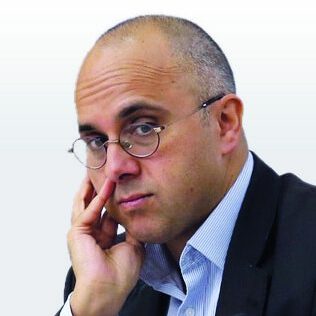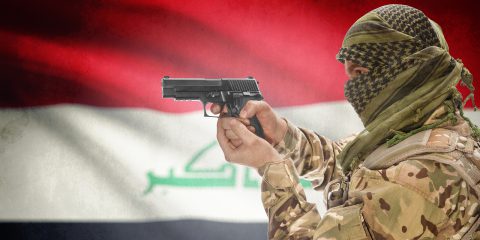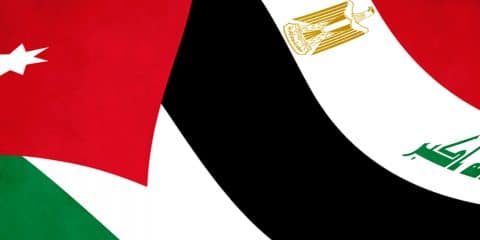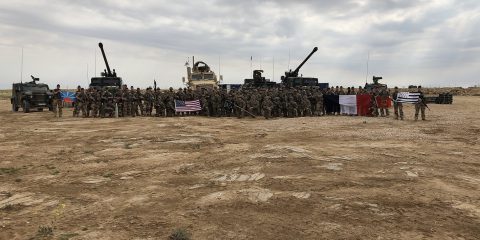Killing of prominent adviser shows the determination of Iranian-backed Shia militias to resist any attempt to curtail their powers and freedom of action.
The killing of Dr Hisham al-Hashimi by gunmen outside his home in the Zeyouneh neighborhood of east Baghdad on July 6 most likely represents a warning to Iraqi Prime Minister Mustafa al-Kadhemi. As such, it is an event of a significance beyond the immediate loss of a prominent political analyst and scholar. If, as appears almost certain because of the circumstances and location of the killing, it was the pro-Iranian Shia militias who killed al-Hashimi, they were sending a clear message to the government. It was to cease forthwith its recent, tentative efforts to reduce the power and autonomy of Iran’s political and military instruments in Iraq.
Al-Hashimi, 47 at the time of his death, was a former Salafi cleric, who had renounced the path of political Islam, and had emerged in recent years as one of the most outspoken critics of ISIS and other Salafi organizations. He had become one of Iraq’s leading experts on Islamic State. His advice was sought by Kadhemi when the latter headed Iraq’s internal intelligence agency. Al-Hashimi also consulted with a variety of Western governments and agencies. He was an adviser to Iraqi President Barham Salih, and he appeared frequently as an analyst on electronic media in Iraq and throughout the Arab world.
Al-Hashimi had served as an adviser on ISIS to the US-led coalition against the organization. However, he was not only critical of the Sunni Salafi jihadis. Following the demise of the ISIS quasi-state in 2018, he turned his attention to the Iran-supported Shia militias and became a trenchant critic of their role in Iraq.
His killing has raised widespread fears in Iraq of a possible return to the years immediately following the US invasion, when both Shia and Sunni militias engaged in insurgency against the occupying forces, and assassinations in Baghdad were commonplace.
This situation had already returned partially following the re-mobilization of the Shia militias in June 2014, to face the advance of ISIS on Baghdad.
From the beginning, and during the ISIS war, the Shia militias used strongarm tactics against their political opponents in Baghdad and other cities. For example, this author interviewed Hikmat Guwood, one of the heads of the Albu Nimr tribe of Anbar Province, in Baghdad in June 2015. Guwood related that he had been threatened by Ktaeb Hizballah (KH) because of his tribes’ involvement with the US during the period of the Sahwa – the Anbar Awakening.
Guwood, having received death threats from KH, removed himself and his family from the city and resettled them in Erbil. His is one of many such cases documented, alongside instances of sectarian murder and ethnic cleansing, committed by the Shia militias at this time.
In this regard, it is also worth noting the 30,000 casualties and more than 500 deaths suffered during demonstrations in the period October 2019-January 2020. The militias played an important, if officially unacknowledged role in the suppression of these demonstrations.
But the murder of Hashimi differs sharply from these previous well-documented violent acts by the Iraqi Shia militias. In recent years, the militias acted with impunity against their opponents precisely because the militias themselves were closely linked to the Iraqi authorities, and hence enjoyed impunity. They envisaged themselves as playing a permanent role in the state, alongside the official armed forces, serving as agents of Iranian influence within official Iraqi power structures. Their goal, as expressed in conversation by an officer of the Badr Corps to this author in Baghdad, was that “in Iran you have the army, and you have the IRGC. So that is how it should be here. We will have the army and the PMU as permanent formations.”
The militia power embedded within the Iraqi state has been developed over the last decade using the combination of political and paramilitary methods which is the praxis of the IRGC/QF, as previously demonstrated in Lebanon. Iranian proxies maintained an independent military capacity (and source of funding), while participating in formal democratic politics.
The result was that political power served to protect the independent military capacity from undue disturbance by the legitimate authorities. In Iraq, the formula was most clearly realized through the Badr Organization’s control, in its political guise, of the Interior Ministry. This gave it power both over the national police forces, and over the very bodies intended to oversee the legally-mobilized Shia militias on behalf of the state. Thus, the political echelon of the Shia militias oversaw the military component, on behalf of the state. It was an optimal arrangement for the Qods Force and its masters, and therefore one they are keen to preserve.
Maintenance of this power structure is essential for the continuation of the Iranian project in Iraq. Any challenge to it must be immediately crushed.
The killing of Hashimi comes precisely amid the first notable attempt by an Iraqi government to curb the power of the militias. Hashimi was himself, as an advisor to President Barham Salih and a close associate of PM Kadhemi, linked to this process, which remains very much in its infancy.
The militias did not welcome the appointment of Kadhemi, who they had previously accused in his role as head of internal intelligence of cooperation with the Americans in the January 3, 2020 killing of IRGC/QF head Qassem Soleimani and Ktaeb Hizballah founder Abu Mahdi al-Muhandis. In recent weeks, they have found their concerns regarding the new prime minister vindicated.
On June 25, Iraqi security forces connected to the Counter-Terrorism Service raided the Ktaeb Hizballah base in Dora, southern Baghdad, and arrested 14 members of the movement. (The fact that the CTS was the force used to arrest the men is significant. This force is widely regarded as loosely aligned with the US, and opposed to the pro-Iran element within the Iraqi system. It was the firing by then Prime Minister Adel Abd al-Mahdi of the then deputy commander of the CTS, General Abd-al Wahab al-Saadi, which triggered the demonstrations in October. Kadhemi, on assuming the prime ministership, reappointed al-Saadi as commander of the CTS).
The 14 were suspected of planning an upcoming Katyusha rocket attack on Baghdad’s Green Zone, where the US embassy is located. Since October, nearly 40 rocket attacks have targeted US military and diplomatic facilities and the facilities of oil companies. US and allied personnel have been killed. Ktaeb Hizballah is considered by US officials to be the main organization behind this campaign, though it denies involvement. The killings of Soleimani and al-Muhandis came in the wake of the deaths of a US contractor and British servicemen in one of the rocket attacks. It is noteworthy that Hashimi himself was one of the first to report the arrests, and was quoted on al-Jazeera and other media outlets on June 26, informing journalists of the important detail that the “defendants were transferred from a prison belonging to the CTS to a detention center under control of al-Hashd in northeast Baghdad.”
The June 25 arrests were the first sign that the Kadhemi government intended to confront Ktaeb Hizballah. The militias reacted angrily, denying that the men were involved in any plan to attack US facilities.
At this point, the government appeared to backtrack, rapidly transferring the arrested men from the custody of the CTS to a facility maintained by the Shia militias themselves, in their legally constituted form (the Popular Mobilization Units – Hashd al Shaabi). On June 26, Abu Ali al-Askari, Ktaeb Hizballah spokesman, said in a statement shared on Telegram that the arrests were an attempt by the “monster Kadhimi,” to hide his involvement in the “criminal murder of two martyrs and their comrades.” (This refers to Soleimani and al-Muhandis). Baghdad’s Green Zone was put under lockdown, as militiamen demanded the release of the detainees
The KH members were released on July 3. They were then filmed burning US and Israeli flags in a public square in Baghdad. Al-Hashimi was assassinated three days later. There has been no claim of responsibility for his killing. But the timing of the killing, the mode of assassination (ISIS rarely engage in attacks on individual prominent figures), and the fact that Hashimi had informed friends on a number of occasions in the preceding period of threats to his life from the militias (specifically from Ktaeb Hizballah), all have led to a tacit consensus that is highly likely that Shia militias are culpable in the murder.
The context here is vital. Kadhimi is set to visit the United States in July. The arrests of the KH members was clearly intended to give him a boost and show the Americans that he was taking measures against the Iranian element in Iraqi public life. However, the killing of Hashimi, following the rapid release of the arrested KH men, reverses this image. It is a classic militia tactic, intended to produce their own version of ‘shock and awe.’ Rather than a gradual, calibrated escalation, the Shia militias appear to have responded to the arrests with a high-level assassination of a Kadhimi ally. The message is: We control the pace of events, not you, and you would be well advised to abandon any further efforts to chip away at militia power – or face unpredictable consequences.
It is now very much the government’s move. It remains to be seen whether on his return from the US, the prime minister will seek to take further action to curtail the freedom of action of the Shia militias, and halt their campaign of attacks on US targets in Iraq. As of now, he has ordered that a Baghdad street be named after Hisham al-Hashimi, (a move leading to some derisive responses on Iraqi social media), and has vowed to bring the killers to justice. In this regard, much may depend on the extent to which he gains the impression that the US will be willing to support him in an escalated confrontation with the militias, which will surely follow any serious attempt to challenge their power in Iraq.
This does not mean further deployment of regular US forces. Indeed, arguably, the presence of 5,000 US servicemen on Iraqi soil serves mainly to provide the militias with a larger target bank. There are other ways to project power. Iran, after all, swallowed up Lebanon and now stands to inherit Iraq with zero conventional forces on the soil of either country. Firm, ongoing, non-time-limited support – economically, politically and operationally – for US-identified political and military forces is the key element. With it, the Kadhimi government stands a fighting chance. Israel, of course, will not be directly involved in Iraq, but Jerusalem too has an interest in the containment and rollback of the Iranian project in Iraq. This is particularly the case given Iranian efforts to deploy missiles capable of reaching Israel with the Shia militias in western Iraq. It is a clear Israeli interest that Iraq should not go the way of Lebanon.
Mona Alami, writing in the pro-Saudi al-Arabiya website, likened the situation in Iraq today directly to that of Lebanon in the 2005 period, when a peace- and growth-oriented political camp faced a violent Iranian proxy political-military organization. The result of that contest was the surrender and subsequent eclipse of the anti-Iran camp in 2008. It is not yet clear whether Iraq will follow this model.
JISS Policy Papers are published through the generosity of the Greg Rosshandler Family.
Photo: altaghier.tv / Bigstock








 - בניית אתרים
- בניית אתרים